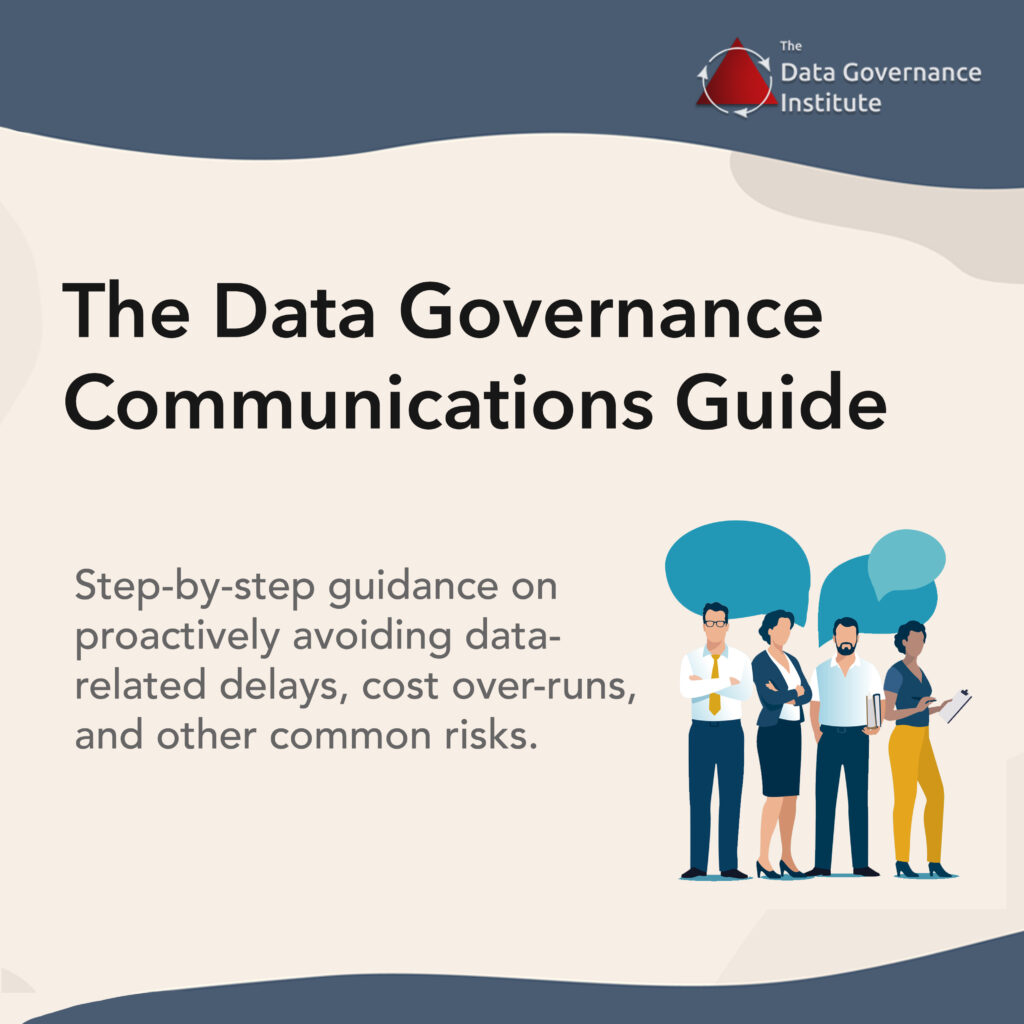Framework Component #10: Data Governance Participants
A Data Governance Office (DGO) facilitates and supports Data Governance and Data Stewardship activities. When focused on “Big G” Governance, such as high-impact decisions, it convenes Decision Bodies and translates their decisions into action items. When focused on execution or “little g” governance controls and activities, it works with Data Stewards & Custodians embedded in functions across the organization.

The Data Governance Office
A Data Governance Office (DGO) facilitates and supports Data Governance and Data Stewardship activities. It…
- runs the program
- keeps track of Data Stakeholders and Stewards
- provides liaisons to other disciplines and programs, such as Data Quality, Compliance, Privacy, Security, Architecture, and IT Governance
- collects and aligns policies, standards, and guidelines from these stakeholder groups
- arranges for the providing of information and analysis to IT projects as requested
- facilitates and coordinates data analysis and issue analysis projects
- facilitates and coordinates meetings of Data Stewards
- collects metrics and success measures and reports on them to data stakeholders
- provides ongoing Stakeholder Care in the form of communication, access to information, record-keeping, and education/support
- articulates the value of Data Governance and Stewardship activities
- provides centralized communications for governance-led and data-related matters
- maintains governance records
How large does your DGO need to be? In some organizations, it’s one person’s time. In others, a team is dedicated to this work. In others, the DGO is an execution arm of a Chief Data Officer.
The make-up of your DGO will depend upon the scope of work you’re trying to accomplish with your program. It will depend on whether your DGO is expected to do its own research and analysis or whether it has consistent access to data management and metadata management resources. Likewise, the size of your DGO will depend on how much “little g” work your teams will be expected to recommend, perform, monitor, and report on.
Don’t underestimate the amount of communication, negotiation, and knowledge-sharing that your DGO staff will need to perform to bring together stakeholders, stewards, and other participants. Especially for organizations that are just formalizing governance, “soft-skill” alignment activities are critically important and can be very time-consuming
Decision Bodies
A data stakeholder is an individual or group that could affect or be affected by the data under discussion. Because Data Stakeholders affect and are affected by data-related decisions, they usually have expectations that must be addressed by the Data Governance program. Some will expect to be included in making data-related decisions. Some will be expected to be consulted before decisions are formalized, and others will be satisfied to be informed of decisions after they are made.
Most Data Governance programs have a Decision Body made up of a set of Data Stakeholders who come together to make data-related decisions. They may set policy and specify standards, or they may craft recommendations that are acted on by a higher-level Decision Body.
Sometimes – especially for large organizations – a single level of decision-makers is inadequate. In this case, a hierarchy of decision bodies may exist, with working groups that address specific data issues or decisions.
Every organization’s approach to Decision Bodies for data-related decisions is unique. It takes into account the organization’s conditions, culture, and management structure. Often, Data Governance programs elevate big decisions to groups that do not have the word “Data” in their names; instead decision-making about data is one of their work streams.
Data Stewards and Custodians
Every organization takes its own unique approach to assigning Data Stewardship and Data Custodian responsibilities. In general, stewards are staff embedded in business and compliance functions, while custodians are embedded in technology and data management functions .
Stewards are often the “eyes and ears” of Data Governance programs, identifying opportunities, challenges, and issues related to data fitness-for-use, usage, and sharing. As individuals who work directly with data, they are familiar with their units’ needs, constraints, and practices. They can advocate for their groups, triggering governance engagements and processes as needed.
Stewards also perform process controls designed to standardize data, ensure its quality, trigger semi-automated controls, approve access rights, write definitions, and more. While some organizations use the term Data Steward for members of Decision Bodies, it is more common for Data Stewards to attend to “little g” governance activities as a part of – or in addition to – their day-to-day activities.
The term Data Custodian is often used to describe technical data stewards. Embedded in technology or data management teams, Custodians general apply controls, configurations, and design choices to their daily work to improve the likelihood that data will meet stakeholder expectations.



